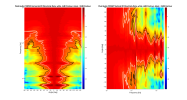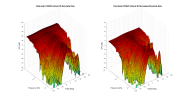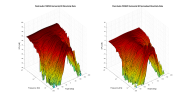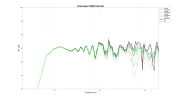This is a review, detailed measurements, listening tests and EQ of version 2 of Fluid Audio FX50 DSP studio monitor/active speaker. It was sent to me by the company and costs US $149 each.

There is nothing visually that distinguishes the unit from the original FX50 I reviewed a while back. The change is in the tuning performed by the internal DSP. Back panel sports usual EQ switches and support for both balanced and unbalanced connections:

Unit was tested with the configuration you see above.
Fluid FX50 V2 Speaker Measurements
Let's start with our family of frequency response measurements:

If we visually smooth out the graph, we see a good attempt at neutral response with flat on-axis that is much better than the original version:

There is curious ringing going on in mid frequencies which we have to analyze subjectively with listening tests due to their closeness with each other. Good directivity due to use of coaxial driver means early window response and predicted in room response resemble on-axis:


Forgot to note the deep (F10) extension to 50 Hz for such a small speaker.
I measured the port response and there is a cabinet resonance that shows up:

We can see clear disturbance in our directivity plots:



For distortion measurements, I added 76 dBSPL:


We see very comfortable response at 76 and 86 dB.
Here are the waterfall and step responses:


Fluid Audio FX50V2 Listening Tests and EQ
Testing was performed in near field (1 meter/3 to 4 foot distance). Out of box sound was surprisingly neutral. There was just a bit of mid frequency muddiness though which I dialed out using very weak filters corresponding with the ringing peaks and one valley (optimized by ear):

The overall improvement was subtle and I am not sure in a controlled test, would survive as an improvement. I was able to enjoy a lot of my reference tracks using this setup, not wanting to stop!
I was impressed with how loud I was play. Turning the volume way up, only gradually increased distortion without any bottoming out, static, or other complaints. I say it was able to play twice as loud as I expected it to!
Sub-pass was played at lower level with some distortion which is way better than many bookshelf speakers.
Conclusions
I applaud Fluid Audio for fine tuning the response of the FX50 to produce a far more neutral response than the OG version. Price/performance is excellent with inclusion of DSP and active, bi-amp design. There is an acoustic (?) problem causing the ringing in response but is easily corrected or ignored.
Overall, I am going to recommend the Fluid Audio FX50V2 studio monitor. It is a great starter system for the desktop.
------------
As always, questions, comments, recommendations, etc. are welcome.
Appreciate any donations using: https://www.audiosciencereview.com/forum/index.php?threads/how-to-support-audio-science-review.8150/
There is nothing visually that distinguishes the unit from the original FX50 I reviewed a while back. The change is in the tuning performed by the internal DSP. Back panel sports usual EQ switches and support for both balanced and unbalanced connections:
Unit was tested with the configuration you see above.
Fluid FX50 V2 Speaker Measurements
Let's start with our family of frequency response measurements:
If we visually smooth out the graph, we see a good attempt at neutral response with flat on-axis that is much better than the original version:
There is curious ringing going on in mid frequencies which we have to analyze subjectively with listening tests due to their closeness with each other. Good directivity due to use of coaxial driver means early window response and predicted in room response resemble on-axis:
Forgot to note the deep (F10) extension to 50 Hz for such a small speaker.
I measured the port response and there is a cabinet resonance that shows up:
We can see clear disturbance in our directivity plots:
For distortion measurements, I added 76 dBSPL:
We see very comfortable response at 76 and 86 dB.
Here are the waterfall and step responses:
Fluid Audio FX50V2 Listening Tests and EQ
Testing was performed in near field (1 meter/3 to 4 foot distance). Out of box sound was surprisingly neutral. There was just a bit of mid frequency muddiness though which I dialed out using very weak filters corresponding with the ringing peaks and one valley (optimized by ear):
The overall improvement was subtle and I am not sure in a controlled test, would survive as an improvement. I was able to enjoy a lot of my reference tracks using this setup, not wanting to stop!
I was impressed with how loud I was play. Turning the volume way up, only gradually increased distortion without any bottoming out, static, or other complaints. I say it was able to play twice as loud as I expected it to!
Sub-pass was played at lower level with some distortion which is way better than many bookshelf speakers.
Conclusions
I applaud Fluid Audio for fine tuning the response of the FX50 to produce a far more neutral response than the OG version. Price/performance is excellent with inclusion of DSP and active, bi-amp design. There is an acoustic (?) problem causing the ringing in response but is easily corrected or ignored.
Overall, I am going to recommend the Fluid Audio FX50V2 studio monitor. It is a great starter system for the desktop.
------------
As always, questions, comments, recommendations, etc. are welcome.
Appreciate any donations using: https://www.audiosciencereview.com/forum/index.php?threads/how-to-support-audio-science-review.8150/









